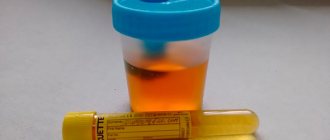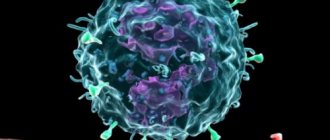After we take tests in the hospital, we are all interested in the result in order to understand the state of our body. When leukocytes in the urine are elevated, the reasons for women can be very different. They signal dysfunction of the genital organs, pathologies or inflammatory processes (for example, cystitis).
general information
White blood cells appear in any part of the body where infectious agents have entered. Certain types of leukocytes penetrate through the capillary walls into the intercellular tissue and participate in the process of phagocytosis. When a pathogen is detected, the protective cells increase in size and “devour” viruses, bacteria and fungi. After destruction, a reaction begins with the accumulation of purulent masses and external signs: the formation of dense, hot, reddened areas.
The penetration of leukocytes into the urine occurs with the development of inflammation in the genitourinary system. White blood cells are found on the mucous membranes; when urine is excreted, leukocytes enter the liquid. For this reason, urine analysis shows a moderate or high number of protective cells.
Doctors diagnose leukocyturia when seven or more units are detected, pyuria - if the material for research contains 60 or more leukocytes in the field of view.
Diagnostics
Excessive levels of leukocytes can be detected after passing a general urinalysis (UCA). If the value of white blood cells is higher than normal, then the woman is sent for analysis using the Nechiporenko method.
If during the study an excess of the norm is revealed, then further diagnostics are performed to detect the cause of such a reaction. Diagnostic procedures include:
- Zimnitsky analysis - necessary to detect pyelonephritis;
- bacterial culture – performed to select an effective antibacterial drug;
- general and biochemical blood tests - make it possible to analyze the erythrocyte sedimentation rate, the number of white blood cells and the level of hemoglobin (thus one can assume the presence of a particular pathology).
If no deviations are found in the above tests, then the woman is referred to a gynecologist to take a smear from the vagina.
Main reasons for increased indicators
Increased leukocytes in urine: what does this mean? The more white blood cells appear in urine, the more active the inflammatory process. The fight against infectious agents necessarily affects the qualitative and quantitative indicators of urine.
Leukocyturia always indicates negative processes in the genitourinary system. Pyuria develops when a large number of pathogenic microorganisms penetrate the tissues and actively fight against the “aggressors”.
Learn about the symptoms and treatments for dysmetabolic nephropathy in children and adults.
Bacteria found in urine: what does this mean and what pathologies does it indicate? Read the answer in this article.
There are more leukocytes in urine than expected in case of pathologies of the genitourinary system:
- cystitis (chronic and acute form);
- venereal diseases;
- vaginitis;
- pyelonephritis;
- urolithiasis and nephrolithiasis;
- glomerulonephritis;
- urethritis;
- lower urinary tract infections.
The second group of reasons that provoke the development of leukocyturia is taking certain types of medications over a long period. Older women often suffer from manifestations of arterial hypertension, bronchopulmonary pathologies, and cardiovascular disorders.
When leukocyturia is detected, the urologist must find out whether the patient is receiving complex therapy, whether she is taking antihypertensive and anti-tuberculosis drugs. It is important to notify your doctor about drugs in these groups to prevent improper treatment. When making a diagnosis, several indicators need to be taken into account. The urologist should pay attention to the clinical picture, the presence or absence of negative signs in the organs of the genitourinary system, and the patient’s subjective sensations.
Also, leukocytes are often elevated in urine due to the use of the following medications:
- drugs from the NSAID group;
- diuretics;
- cyclophosphamides;
- sulfonamides;
- drugs to normalize cardiac activity;
- cephalosporins;
- names used in organ transplantation.
On a note! Hormonal imbalances and ovarian dysfunction negatively affect the condition of the vaginal mucosa. The lack of secretion provokes a decrease in local immunity, making it easier for pathogenic microorganisms to attach to the walls of the vagina. The proximity of the urethra and external genitalia in women explains the active penetration of infectious agents into neighboring areas, including the urinary tract.
Causes of increased leukocytes in urine
An increased level of these blood elements most often indicates the presence of a pathological abnormality in the activity of the urinary system.
Among women
To establish a complete picture of the disease, additional diagnostics and re-analysis may be required.
But most often, an increased level of leukocytes indicates the presence of the following diseases in the female body:
- cystitis;
- pyelonephritis;
- vaginitis;
- vulvovaginitis;
- thrush;
- oncological diseases.
Pregnancy can also cause the appearance of white blood cells. This is explained by the fact that during this period the activity of hormones increases.
But if their level significantly exceeds the norm, without decreasing over a long period, then most likely there is an infection in the body. In this case, a visit to the doctor is simply necessary.
In men
An increased level of leukocytes in the urine of men can be caused by the presence of many diseases, the development of which is caused by an inflammatory process.
The increase in content may be due to:
- prostatitis;
- balanoposthitis - inflammation of the glands at the outer edge of the urethra;
- prostate adenocarcinoma;
- phimosis - narrowing of the foreskin;
- prostate adenoma;
- sexually transmitted infections.
Regardless of gender
An increase in white blood cell levels may also be caused by the presence of other factors.
White blood cells may be found due to:
- excessive physical activity (especially static, caused by lifting weights);
- fever;
- taking antibiotics (penicillins, aminoglycosides);
- treatment with non-steroidal anti-inflammatory drugs (Ketoprofen, Diclofenac, Indomethacin);
- use of radiocontrast agents;
- use of iron supplements.
Sometimes the results can be distorted by poor hygiene before collecting biomaterial and the use of a non-sterile container.
Signs of an inflammatory process
Inflammation in the genitourinary system has characteristic symptoms. In the chronic form of the pathology, symptoms worsen during relapses; during remission, negative sensations are mild or the woman experiences virtually no discomfort.
The development of leukocyturia and pyuria can be assumed in the presence of the following symptoms:
- pain in the lower abdomen, lumbar area;
- discomfort, burning sensation when urinating or at the end of the urine excretion process;
- weakness, poor health;
- elevated subfertile temperature;
- you feel chills, taking antipyretic compounds and warmer clothes do not bring relief: it is difficult to warm up;
- Yellow or brownish spots regularly appear on underwear, often mixed with blood and pus;
- Vaginal dryness increases and discomfort occurs. With a decrease in local immunity, pathogenic microorganisms actively multiply on dried out mucous membranes: bacteria, fungi and viruses penetrate the urethra. With the development of vaginitis, the indicators are often 2 times higher than the permissible values;
- trips for minor needs become more frequent, but the volume of fluid decreases, the feeling of heaviness and distension in the bladder is disturbing, but the next time you urinate it is noticeable: there is very little urine in the cavity;
- purulent masses, protein, sand, blood clots, and mucus appear in the excreted fluid. Transparency and color change: urine is cloudy, the shade is often darker than usual. Sometimes the color of urine resembles “meat slop”, a sharp, unpleasant odor appears, and a grayish-white suspension indicates serious problems with the functioning of the kidneys and bladder.
Leukocyte esterase in urine
If the conditions for storing and transporting the assay are not met, the cells can rapidly deteriorate. If the urine sample was not transported and moved within 3-4 hours into a special container that contains a special preservative that prevents the destruction of leukocytes in a urine test, then the results obtained may be distorted.
What means
The leukocyte esterase enzyme is detected even when cells are destroyed in urine suspension. The level of this substance clearly indicates the activity of leukocytes in the urinary system.
This term is now increasingly heard when it comes to diagnosing pathologies of the urinary system. Such analysis appeared relatively recently.
This substance is a hydrolytic enzyme that is contained in the cavity of lymphocytes and takes part in the processes of phagocytosis (intracellular breakdown of absorbed bacterial agents).
The presence of leukocyte esterase in a urine test indicates the development of an inflammatory process in the organs of the urinary system. This may be a sign of the development of various pathological processes in the kidneys, ureters, bladder, and urethra.
Norm
Normally, when examining urine, their content in the field of view should not be more than 3 or 5 cells for men and women, respectively. If the amount is higher, the doctor will suspect the development of a urinary tract infection.
The higher the content of phagocytic cells, the higher the levels of leukocyte esterase.
Determination of the level of presence of the leukocyte enzyme is semi-quantitative. This is done using test strips. Different manufacturers of such diagnostic instruments may have different scales for assessing results.
The lower sensitivity threshold of the analysis is about 5 cells per field of view. If their number in urine is less than or equal to the specified amount, the esterase test will be negative.
Promotion
The indicator “leukocyte esterase +++” indicates that more than 500 leukocytes were found in 1 μl of urine, which destroyed harmful bacteria with their enzymes.
High concentrations are usually observed in the presence of one of the following diseases:
- Cystitis. Often this disease develops in women due to easier penetration of infection into the bladder due to the anatomical structure of their genital organs. Many women know about the symptoms of cystitis - pain in the lower abdomen, frequent urge and painful urination, increased body temperature and the appearance of traces of blood in the urine.
- Pyelonephritis. This disease often becomes a complication of cystitis. It can appear in the absence of adequate treatment, as a result of which a bacterial infection penetrates the kidneys and causes inflammation. Symptoms of pyelonephritis are quite severe: high body temperature, general weakness, lower back pain, nausea and vomiting.
- Urethritis. This is an inflammatory process on the mucous membrane of the urethra. Most often, older men suffer from urethritis. Due to inflammation of the urethra, there is pain and pain when urinating, which makes this process very painful.
- Gematria. This is the appearance of red blood cells in the urine. The patient himself can detect this disease by noticing blood. This disease can occur as a result of the formation of stones in the kidneys or gall bladder, inflammation of the bladder, or injuries to the genitourinary system.
During pregnancy, a woman's bladder experiences significant pressure from the abdomen, and its volume increases. This leads to problems with complete emptying of the bladder, which in turn leads to the creation of a favorable environment for the development of pathogenic microorganisms.
It happens that, according to the results of a general urine test, leukocyte esterase is higher than normal, but according to the results of a microscopic examination, the content is within acceptable limits. In this case, there are no serious reasons to suspect the presence of inflammation in the genitourinary organs.
False negative results can be obtained for the following reasons:
- taking antibiotics and other medications;
- failure to comply with intimate hygiene rules before collection;
- violation of the rules for collecting analysis;
- urine concentration is too high;
- for allergies, diabetes,
- with increased levels of bile pigment urobilinogen, protein or ascorbic acid in the urine.
Norm and deviations
In the absence of an inflammatory process, leukocytes in urine are not detected during general analysis of the excreted fluid. Acceptable values for women are no more than five white blood cells per field of view. If a patient undergoes a urine test according to Nechiporenko, then the norm of leukocytes in urine in women is 4000 units.
Exceeding the indicators even by three or four points is a reason to retake the analysis and clarify the number of leukocytes. There may have been irregularities during urine collection. When confirming the results, consultation with a urologist and gynecologist is required.
Rules for collecting urine in children and adults
High-quality collection of material for analysis is the key to accurately determining an elevated level of leukocytes, and therefore identifying probable diseases. Morning urine must be provided for testing. It is better to purchase a special disposable container for donating urine, which will be guaranteed clean. Within an hour and a half, the container with the contents must be provided to the institution that collects the tests. If storage is required, this should be done in the refrigerator. Material that has become cloudy or changed color while being delivered to the clinic will not be suitable.
It is quite difficult to obtain the required amount of clean urine from an infant, so we list several rules for its collection:
- Material for examination is collected immediately after the baby wakes up
- Before the collection process, the baby should be washed thoroughly using soap or another product.
- The container must be disposable and clean
- The process can be significantly simplified with the help of a mochesbonik. Follow the instructions on how to use it
- To stimulate the child, you can give the child a little drink, then turn on the water in the bathroom
Preparing for urine collection
Recommendations:
- purchase a plastic container for the removed liquid. A container with a tight lid does not allow microorganisms from the environment to enter;
- 2 hours should pass between night urination and taking the test. Doctors recommend filling the container from 7 to 10 o'clock;
- Before collecting urine, wash your genitals, but do not use antibacterial compounds;
- During menstruation, you should not have your urine tested;
- the best option is to insert a cotton-gauze swab into the vagina before urinating, so that the flora from the walls of the mucous membrane does not get into the urine;
- open the container, collect at least 40–50 ml of liquid, immediately close the container, and continue emptying the bladder;
- take the urine to the laboratory within two hours. Store the material in a cool place: in the heat, bacteria actively multiply in the collected liquid.
How to treat an increased white cell count
Treatment depends on the cause that caused the appearance of leukocyturia. Only an experienced specialist can determine it and choose the right medicine, so you should not self-medicate, as this can only lead to a worsening of the condition.
- For bacterial infections, antibiotics are used, which are applied locally (vaginal suppositories, bladder lavage) and administered by injection or in the form of tablets; drugs such as Ceftriaxone, Ampicillin, Tetracycline are popular.
- To treat a viral infection, antiviral drugs are used, as well as symptomatic treatment.
- Allergic conditions are relieved with the help of antihistamines - Suprastin, Diphenhydramine.
- Tumor formations are treated surgically using radiation and chemical therapy.
Minor leukocyturia during pregnancy and the postpartum period does not require treatment, you just need to monitor the dynamics of changes.
If there is an increase in leukocytes in the urine after taking medications, the doctor will reduce the dosage or select analogues.
Decoding the results
Indicators of 5–20 units are signs of the following pathologies:
- glomerulonephritis – a disease of immunoallergic etiology;
- sluggish infectious pathologies of the urinary tract;
- nephropathy;
- chronic inflammation of the renal tubules.
Indicators of 20 units and above indicate an acute form:
- urethritis;
- cystitis;
- pyelonephritis.
How to Lower Your White Blood Cell Count
Is the deviation in the indicators related to long-term use of the medications listed in the “Causes” section? Don't worry: after stopping the drug and finishing treatment, the level of white blood cells in most cases returns to normal. In some cases, the urologist will forgive another highly specialized specialist: cardiologist, ENT doctor, gastroenterologist, dermatologist to replace the drug with an analogue if the level of leukocytes is noticeably elevated.
When treating severe infectious pathologies, such as tuberculosis, the components of potent drugs kill dangerous microorganisms for 6–12 months. The cessation of the inflammatory process and the cure of the patient leads to normalization of the level of leukocytes in urine.
To normalize the indicators, a comprehensive examination and treatment is required, taking into account the type of disease and the severity of the pathology. In case of an inflammatory process, detection of bacteria in the urine, urine culture is required to select the most powerful antibiotic. To treat other types of infection, antimycotic and antiviral compounds are used.
The best option is a combination of local remedies (vaginal and rectal suppositories, creams, gels, ointments) with systemic medications for oral administration or injections (for severe forms of the disease).
Learn about the causes of salt deposits in the kidneys and the rules for removing deposits.
The symptoms of pyeelectasis of the right kidney in a child and the treatment of the pathology are written on this page.
Go to https://vseopochkah.com/mochevoj/zabolevaniya/tsistit-u-detej.html and read about what and how to treat cystitis in children of different ages.
To eliminate inflammation, a complex of drugs is selected taking into account the etiology, stage and form of the disease:
- nitrofurans;
- antibiotics;
- uroseptics;
- diuretics;
- antispasmodics;
- antiallergic tablets;
- analgesics;
- medications that prevent the accumulation of salt deposits;
- drugs that dissolve stones in the kidneys and urinary tract.
It is forbidden to use medications without consulting a specialist: infectious lesions of the genitourinary system require identification of the pathogen, otherwise the therapy will be harmful or the result will not appear. It is important to know: antiviral compounds are ineffective in identifying fungi and bacteria.
How to take a urine test correctly?
In order for a urine test to show the correct result, it must be collected according to all the rules. A general urine test must be collected in a clean container with a flat bottom, then closed with a lid. Before you collect urine, you need to wash your intimate organs well with soap. If you don't donate urine right away, be sure to store it in a cool place.
So, it is very important to periodically take a general urine test, because an increase in white blood cells can indicate serious diseases of the genitourinary system and kidneys. Not only tests, but also some signs indicate inflammation; pain in the lower abdomen often occurs, and urination becomes difficult. Also due to allergic reactions. If there are no pronounced symptoms, this indicates that you took the test incorrectly, and it is best to retake it. Pay attention to the container in which you take the test, it must be clean, it is best to buy a special one for this, which is sold in pharmacies. Problems can occur in both adult children and newborns, which is why it is so important to monitor their health so as not to worsen the disease. Especially often, leukocytes increase in pregnant women, and this is dangerous both for the fetus and for the woman’s health.












